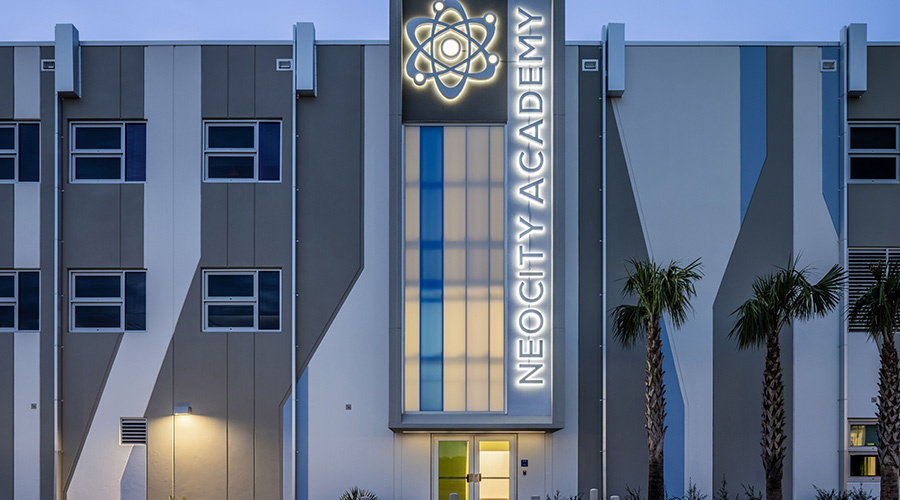Florida Magnet High School Forms Net-Zero Blueprint for K-12 Districts

Osceola County School District’s NeoCity Academy forms design blueprint for future K-12 buildings.
“School tour guide” isn’t typically part of the job description for a chief facilities officer (CFO) in a K-12 school district, but Dave Sharma doesn’t mind taking extra time to show off his district’s prized building.
Sharma is the CFO for the Osceola County School District in Florida, and one of the district’s newest schools, NeoCity Academy, is a hit with school districts across the state and country for its energy efficiency.
“I think we’ve done over 500 tours of NeoCity,” says Sharma, who doesn’t lead every tour, but does his share.
The first high-performance, net-zero energy public school in the state has become a star, and that’s before mentioning its reputation as one of the top academic high schools in Florida.
An energy marvel
NeoCity Academy is part of the NeoCity Campus tech hub in Kissimmee. With the 500-acre campus consisting of a mix of research companies and new-age manufacturing facilities — all built with sustainable practices in mind — it only seemed appropriate that a magnet high school placing an emphasis on science, technology, engineering and mathematics (STEM) subjects would be placed there as well.
The NeoCity Campus was launched in 2014, and NeoCity Academy opened in fall 2019. The district spent $13.2 million to build the 45,000-square-foot-school that included 400 students (and has since expanded to 525). Four years later, a 52,000-square-foot expansion covering three stories more than doubled the size of the school.
Marc Clinch was the Osceola district’s CFO and oversaw construction of the first section of NeoCity Academy before moving on in 2023. The district’s plan was an ambitious one that exceeded expectations.
“We proved that it is possible to build a high-performance, and net-zero energy building with minimal premiums and a quick return on investment with an ultra-low energy usage but many other benefits as well,” he says. “The school, because it is so tight, it’s also very durable. Since the envelope is very durable, you know that moisture will not easily penetrate the building.”
A tight building envelope was the key to the school’s energy-saving success, Clinch says. With a tighter building, the HVAC system footprint could be smaller, significantly eliminating costs for heating and cooling. Little Diversified Architectural Consulting, the company that designed the building, installed 38 heat pumps for the HVAC system and a 650-panel, 227.9-kilowatt solar array to produce the building’s electricity.
The resulting energy savings results from the first building exceeded the district’s expectations in several ways, starting with an air leakage rate of 0.027 cubic feet per minute (CFM), well below the district’s goal of 0.15 CFM and paving the way for the following energy statistics:
An energy use intensity (EUI) rating of 20, compared to the school national average of 68.
- $115,000 in annual energy savings compared to other schools, or 76 percent less energy use than a typical Florida school.
- A net-positive energy surplus generated 365 kilowatts per hour (kWh) while consuming only 346 kWh.
- The district anticipated a 7.5 year return on investment that was achieved in six years.
“We estimated conservatively and didn’t want to over-inflate and embellish,” Clinch says. “We wanted to provide a model that was truly achievable, and we did that.”
Special treatment was also necessary for the building orientation plan. Designers had to comply with a requirement that 60 percent of the front of the building had to be located within 10 feet of the main street. This hurdle adjusted the designers’ daylighting and solar harvesting plans and influenced the courtyard design that is also used for outdoor learning environments.
To help monitor energy use and ensure the school’s commitment to net-zero energy, the designers placed sensors throughout the building to record indoor air quality and temperature and room occupancy data so that staff and maintenance teams can adjust the mechanical systems accordingly based on occupancy. When the building wasn’t achieving the anticipated energy savings early on, designers sought to determine why.
Philip Donovan, the Little architect and building designer, says the staff initially was not trained in how to best take advantage of the system by setting controls to adjust spaces based on how they were occupied during the day and after school hours. Upon correcting that oversight, the energy savings emerged.
“My profession has done a really bad job of just saying, ‘We designed this cool building, just make it work,’” Donovan says. “We have to get the building constructed and then make sure everybody on the owner’s side understands how it should be operated.”
Second stage
With the successful launch of NeoCity Academy, and a growing demand for district students to attend the school, plans were already in the works for the second stage of the building when Sharma came to Osceola County in 2019. Construction of the second part of the building started in March 2023 and was completed in summer 2024.
“There was always a master plan for a second building,” he says. “We toyed with the idea of building a middle school component and then kind of fit it into the high school, but we had enough middle school seats already. And from a zoning standpoint, it just didn’t make sense, and there was a waiting list of students that wanted to apply for the magnet (school), and we were out of seats.”
In many ways, the second part of the building was a mirror image of the first. Budget constraints limited the first part of the school to 2.5 stories, but the expansion included three stories. The HVAC system was kept the same, solar panels were added, and the approach to the building envelope was replicated.
The second part of the building included a new cafeteria, additional media spaces for students to work collaboratively outside of the traditional classroom setting and other study labs for schoolwork.
“We changed very few things, like minor details, such as in the bathrooms,” Sharma says. “In the first version, we had some lighting that proved to be hard to maintain accessing it, so we changed the concept. Door closures were added, and we conditioned the stairwells, because in the first version we didn’t condition them. We also picked up some things that operationally didn’t work well for us in the first version, and we corrected those.”
Setting the standard
When a school district achieves such energy-saving success with a new building, other districts and organizations take notice and want to learn more about how it was done.
During the recent Green Schools Conference hosted by the U.S. Green Building Council (USGBC) in Orlando, NeoCity Academy students hosted tours for dozens of conference attendees to see what all the fuss is about. The story the students told was one of sustainability, reduced energy use, and establishing a blueprint that the district and many others beyond Osceola County’s borders have already implemented.
“As a former teacher, I was impressed by the students’ enthusiasm for their school, their knowledge and their appreciation for their school’s sustainability commitments, and their love of learning,” says Karen Jernigan, director of U.S. Market Transformation and Development for the USGBC. “They credited the school’s design, academic opportunities and the vibrant community they experience as the key factors that set them apart from other schools.”
NeoCity is just the first step for the Osceola County School District in its net-zero journey. The district has opened three more schools designed with the same approach it took with NeoCity, with another one on the way, says Sharma.
The district conducts workshops and does outreach to tell its story of how schools can benefit the community and are worthwhile investments of taxpayer dollars in addition to the academic benefits for the students who attend NeoCity, says Sharma. While public money isn’t always readily available in some districts, the trust that Osceola County taxpayers have placed in their school district isn’t lost on Sharma.
“We know it’s something that comes out of their pocket, but the idea for us is to show transparency,” he says. “We are spending this money as efficiently as possible.”
Among those 500 NeoCity school tours are representatives from larger state districts such as Miami-Dade County and West Palm Beach County. With more than 78,000 students and 84 buildings in one of the fastest-growing counties in Florida, Osceola County is hardly a lightweight, but Sharma takes pride in knowing that his district is setting a standard for net-zero buildings.
“We no longer think of ourselves as a small district or one that follows the trends,” Sharma says. “We’re suddenly the ones that push the envelope within reason, and we’re still building at a pace, and at a price, that is not much different than peers around us. We are building a classroom and environment which supports what we’re trying to do, which is educating students to the best of our ability.”
By Dave Lubach, Executive Editor
Dave Lubach is the executive editor of the facilities market. He has 10 years of experience writing about facility management and maintenance issues.
Related Topics:
The post "Florida Magnet High School Forms Net-Zero Blueprint for K-12 Districts" appeared first on Building Operating & Management

